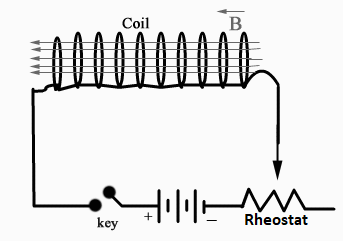
Derive expression for the self-induction of solenoid. What factors affect its value and how?
Answer
540.9k+ views
Hint: Find the magnetic flux linked with the solenoid. Assume the solenoid to be very long, and the magnetic flux to be uniform inside at each point. Then find the self-inductance of the solenoid, where there is a substance of relative permeability instead of air or vacuum.
Complete step by step answer:

Here in the diagram, we see a coil in which current is passed with the help of a DC source, and a rheostat to control the current supplied, we see that the direction of current supplied is totally opposite to the magnetic flux induced in the coil.
Self Inductance of a Current-Carrying Solenoid: Consider a solenoid of radius r meter, length l meter, having a total number of turns N and carrying a current I ampere. The magnetic field produced on its axis inside the solenoid is
$B=\dfrac{{{\mu }_{0}}NI}{l}N{{A}^{-1}}{{m}^{-1}}$
If it is assumed that the solenoid is very long, the intensity of magnetic field B can be assumed to be uniform inside it at each point, then the total magnetic flux linked with the solenoid is
$B=\dfrac{{{\mu }_{0}}m}{4\pi }[\dfrac{{{d}^{2}}+{{l}^{2}}+2dl-({{d}^{2}}+{{l}^{2}}-2dl)}{{{\{(d-l)(d+l)\}}^{2}}}]$
$\phi =B\times $Total effective area of the solenoid.
$=B\times (NA)$
Where $A=\pi {{r}^{2}}$ is the area of the cross section of solenoid.
$\therefore \quad \quad \phi =\dfrac{{{\mu }_{0}}NI}{l}\times NA=\dfrac{{{\mu }_{0}}{{N}^{2}}AI}{l}$weber.
But by definition ϕ=LI where L is the self-inductance of the solenoid, therefore
$L=\dfrac{\phi }{I}=\dfrac{{{\mu }_{0}}{{N}^{2}}A}{l}$henry,
If inside the solenoid instead of air or vacuum there is a substance of relative permeability
$L=\dfrac{{{\mu }_{0}}{{\mu }_{r}}{{N}^{2}}A}{l}$
Thus, the self-inductance of a solenoid depends on the following factors:
(i) The self-inductance increases on increasing the number of turns, which means it depends on the number of turns in the coil of the solenoid.
(ii) The self-inductance increases on increasing the area of cross-section, which means it depends on the area of cross-section or radius of the solenoid.
(iii) On increasing the length of solenoid, its self-inductance decreases.
(iv) If a soft iron rod is placed inside the solenoid, its self-inductance increases, which means it depends on the relative permeability of the substance placed inside the solenoid.
We have to remember that if the number of turns per unit length of the solenoid is n, then n=N/l and the self-inductance of the solenoid is,
$L={{\mu }_{0}}{{n}^{2}}lA$
Note: Consider the magnetic field to be uniform throughout the solenoid. Remember to find the solution within the medium of relative permeability.Larger the length of the solenoid lesser is its self-inductance.
Complete step by step answer:

Here in the diagram, we see a coil in which current is passed with the help of a DC source, and a rheostat to control the current supplied, we see that the direction of current supplied is totally opposite to the magnetic flux induced in the coil.
Self Inductance of a Current-Carrying Solenoid: Consider a solenoid of radius r meter, length l meter, having a total number of turns N and carrying a current I ampere. The magnetic field produced on its axis inside the solenoid is
$B=\dfrac{{{\mu }_{0}}NI}{l}N{{A}^{-1}}{{m}^{-1}}$
If it is assumed that the solenoid is very long, the intensity of magnetic field B can be assumed to be uniform inside it at each point, then the total magnetic flux linked with the solenoid is
$B=\dfrac{{{\mu }_{0}}m}{4\pi }[\dfrac{{{d}^{2}}+{{l}^{2}}+2dl-({{d}^{2}}+{{l}^{2}}-2dl)}{{{\{(d-l)(d+l)\}}^{2}}}]$
$\phi =B\times $Total effective area of the solenoid.
$=B\times (NA)$
Where $A=\pi {{r}^{2}}$ is the area of the cross section of solenoid.
$\therefore \quad \quad \phi =\dfrac{{{\mu }_{0}}NI}{l}\times NA=\dfrac{{{\mu }_{0}}{{N}^{2}}AI}{l}$weber.
But by definition ϕ=LI where L is the self-inductance of the solenoid, therefore
$L=\dfrac{\phi }{I}=\dfrac{{{\mu }_{0}}{{N}^{2}}A}{l}$henry,
If inside the solenoid instead of air or vacuum there is a substance of relative permeability
$L=\dfrac{{{\mu }_{0}}{{\mu }_{r}}{{N}^{2}}A}{l}$
Thus, the self-inductance of a solenoid depends on the following factors:
(i) The self-inductance increases on increasing the number of turns, which means it depends on the number of turns in the coil of the solenoid.
(ii) The self-inductance increases on increasing the area of cross-section, which means it depends on the area of cross-section or radius of the solenoid.
(iii) On increasing the length of solenoid, its self-inductance decreases.
(iv) If a soft iron rod is placed inside the solenoid, its self-inductance increases, which means it depends on the relative permeability of the substance placed inside the solenoid.
We have to remember that if the number of turns per unit length of the solenoid is n, then n=N/l and the self-inductance of the solenoid is,
$L={{\mu }_{0}}{{n}^{2}}lA$
Note: Consider the magnetic field to be uniform throughout the solenoid. Remember to find the solution within the medium of relative permeability.Larger the length of the solenoid lesser is its self-inductance.
Recently Updated Pages
A man running at a speed 5 ms is viewed in the side class 12 physics CBSE

The number of solutions in x in 02pi for which sqrt class 12 maths CBSE

State and explain Hardy Weinbergs Principle class 12 biology CBSE

Write any two methods of preparation of phenol Give class 12 chemistry CBSE

Which of the following statements is wrong a Amnion class 12 biology CBSE

Differentiate between action potential and resting class 12 biology CBSE

Trending doubts
What are the major means of transport Explain each class 12 social science CBSE

Which are the Top 10 Largest Countries of the World?

Draw a labelled sketch of the human eye class 12 physics CBSE

How much time does it take to bleed after eating p class 12 biology CBSE

Explain sex determination in humans with line diag class 12 biology CBSE

Explain sex determination in humans with the help of class 12 biology CBSE




